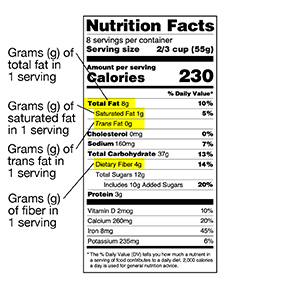Food is your body’s fuel. You can’t live without it. The key is to give your body enough nutrients and energy without eating too much. Reading food labels can help you make healthy choices. Also, learn new eating habits to manage your weight. Nutrition labels are being redesigned by the FDA to emphasize the number of calories being consumed as well as the amount of more nutrients. These include added sugars, vitamin D, and potassium.
Eat less fat
A gram of fat has almost 2.5 times the calories of a gram of protein or carbohydrates. Try to balance your food choices so that only 20% to 35% of your calories comes from total fat. This means an average of 2½ to 3½ grams of fat for each 100 calories you eat.
Eat more fiber
High-fiber foods are digested more slowly than low-fiber foods. This helps you feel full longer. Try to get at least 25 grams of fiber each day for a 2000 calorie diet. Foods high in fiber include:
-
Vegetables and fruits
-
Whole-grain or bran breads, pastas, and cereals
-
Legumes (beans) and peas
As you start to eat more fiber, be sure to drink plenty of water. It will help keep your digestive system working smoothly.
Tips
Do's and don'ts include:
-
Eat a variety of foods, not just a few favorites.
-
If you find yourself eating when you’re not hungry, ask yourself why. Many of us eat when we’re bored, stressed, or just to be polite. Listen to your body. If you’re not hungry, get busy doing something else instead of eating.
-
Eat slower, shooting for 20 to 30 minutes for each meal. It takes 20 minutes for your stomach to tell your brain that it’s full. Slow eaters tend to eat less and are still satisfied, while fast eaters may tend to over eat.
-
Pay attention to what you eat. Don’t read or watch TV during your meal.
-
If you are already overweight, ask your healthcare provider for a referral to a dietitian who can help you make better choices regarding all types of foods.
Featured in


